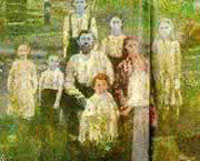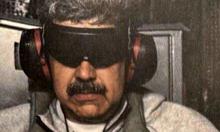Blue people inhabited Kentucky in 1950s
Six generations after a French orphan named Martin Fugate settled on the banks of eastern Kentucky's Troublesome Creek with his redheaded American bride, his great-great-great great grandson was born in a modern hospital not far from where the creek still runs.

The boy inherited his father's lankiness and his mother's slightly nasal way of speaking.
What he got from Martin Fugate was dark blue skin. "It was almost purple," his father recalls.
Doctors were so astonished by the color of Benjamin "Benjy" Stacy's skin that they raced him by ambulance from the maternity ward in the hospital near Hazard to a medical clinic in Lexington.
Two days of tests produced no explanation for skin the color of a bruised plum.
A transfusion was being prepared when Benjamin's grandmother spoke up. "Have you ever heard of the blue Fugates of Troublesome Creek?" she asked the doctors.
"My grandmother Luna on my dad's side was a blue Fugate. It was real bad in her," Alva Stacy, the boy's father, explained. "The doctors finally came to the conclusion that Benjamin's color was due to blood inherited from generations back."
Benjamin lost his blue tint within a few weeks, and now he is about as normal looking a seven-year-old boy as you could hope to find. His lips and fingernails still turn a shade of purple-blue when he gets cold or angry a quirk that so intrigued medical students after Benjamin's birth that they would crowd around the baby and try to make him cry. "Benjamin was a pretty big item in the hospital," his mother says with a grin.
Dark blue lips and fingernails are the only traces of Martin Fugate's legacy left in the boy; that, and the recessive gene that has shaded many of the Fugates and their kin blue for the past 162 years.
They're known simply as the "blue people" in the hills and hollows around Troublesome and Ball Creeks. Most lived to their 80s and 90s without serious illness associated with the skin discoloration. For some, though, there was a pain not seen in lab tests. That was the pain of being blue in a world that is mostly shades of white to black.
There was always speculation in the hollows about what made the blue people blue: heart disease, a lung disorder, the possibility proposed by one old-timer that "their blood is just a little closer to their skin." But no one knew for sure, and doctors rarely paid visits to the remote creekside settlements where most of the "blue Fugates " lived until well into the 1950s. By the time a young hematologist from the University of Kentucky came down to Troublesome Creek in the 1960s to cure the blue people, Martin Fugate's descendants had multiplied their recessive genes all over the Cumberland Plateau.
Madison Cawein began hearing rumors about the blue people when he went to work at the University of Kentucky's Lexington medical clinic in 1960. "I'm a hematologist, so something like that perks up my ears," Cawein says, sipping on whiskey sours and letting his mind slip back to the summer he spent "tromping around the hills looking for blue people."
Cawein would drive back and forth between Lexington and Hazard an eight-hour ordeal before the tollway was built and scour the hills looking for the blue people he'd heard rumors about. The American Heart Association had a clinic in Hazard, and it was there that Cawein met "a great big nurse" who offered to help.
Her name was Ruth Pendergrass, and she had been trying to stir up medical interest in the blue people ever since a dark blue woman walked into the county health department one bitterly cold afternoon and asked for a blood test.
"She had been out in the cold and she was just blue!" recalls Pendergrass, who is now 69 and retired from nursing. "Her face and her fingernails were almost indigo blue. It like to scared me to death! She looked like she was having a heart attack. I just knew that patient was going to die right there in the health department, but she wasn't a'tall alarmed. She told me that her family was the blue Combses who lived up on Ball Creek. She was a sister to one of the Fugate women." About this same time, another of the blue Combses, named Luke, had taken his sick wife up to the clinic at Lexington. One look at Luke was enough to "get those doctors down here in a hurry,"says Pendergrass, who joined Cawein tolook for more blue people.
Trudging up and down the hollows, fending off "the two mean dogs that everyone had in their front yard," the doctor and the nurse would spot someone at the top of a hill who looked blue and take off in wild pursuit. By the time they'd get to the top, the person would be gone. Finally, one day when the frustrated doctor was idling inside the Hazard clinic, Patrick and Rachel Ritchie walked in.
"They were bluer'n hell," Cawein says. "Well, as you can imagine, I really examined them. After concluding that there was no evidence of heart disease, I said 'Aha!' I started asking them questions: 'Do you have any relatives who are blue?' then I sat down and we began to chart the family."
Cawein remembers the pain that showed on the Ritchie brother's and sister's faces. "They were really embarrassed about being blue," he said. "Patrick was all hunched down in the hall. Rachel was leaning against the wall. They wouldn't come into the waiting room. You could tell how much it bothered them to be blue."
After ruling out heart and lung diseases, the doctor suspected methemoglobinemia, a rare hereditary blood disorder that results from excess levels of methemoglobin in the blood. Methemoglobin which is blue, is a nonfunctional form of the red hemoglobin that carries oxygen. It is the color of oxygen-depleted blood seen in the blue veins just below the skin.
If the blue people did have methemoglobinemia, the next step was to find out the cause. It can be brought on by several things: abnormal hemoglobin formation, an enzyme deficiency, and taking too much of certain drugs, including vitamin K, which is essential for blood clotting and is abundant in pork liver and vegetable oil.
Cawein drew "lots of blood" from the Ritchies and hurried back to his lab. He tested first for abnormal hemoglobin, but the results were negative.
Stumped, the doctor turned to the medical literature for a clue. He found references to methemoglobinemia dating to the turn of the century, but it wasn't until he came across E. M. Scott's 1960 report in the Journal of Clinical Investigation (vol. 39, 1960) that the answer began to emerge.
Scott was a Public Health Service doctor at the Arctic Health Research Center in Anchorage who had discovered hereditary methemoglobinemia among Alaskan Eskimos and Indians. It was caused, Scott speculated, by an absence of the enzyme diaphorase from their red blood cells. In normal people hemoglobin is converted to methemoglobin at a very slow rate. If this conversion continued, all the body's hemoglobin would eventually be rendered useless. Normally diaphorase converts methemoglobin back to hemoglobin. Scott also concluded that the condition was inherited as a simple recessive trait. In other words, to get the disorder, a person would have to inherit two genes for it, one from each parent. Somebody with only one gene would not have the condition but could pass the gene to a child.
Scott's Alaskans seemed to match Cawein's blue people. If the condition were inherited as a recessive trait, it would appear most often in an inbred line.
Cawein needed fresh blood to do an enzyme assay. He had to drive eight hours back to Hazard to search out the Ritchies, who lived in a tapped-out mining town called Hardburly. They took the doctor to see their uncle, who was blue, too. While in the hills, Cawein drove over to see Zach (Big Man) Fugate, the 76-year-old patriarch of the clan on Troublesome Creek. His car gave out on the dirt road to Zach's house, and the doctor had to borrow a Jeep from a filling station.
Zach took the doctor even farther up Copperhead Hollow to see his Aunt Bessie Fugate, who was blue. Bessie had an iron pot of clothes boiling in her front yard, but she graciously allowed the doctor to draw some of her blood.
Just like the Alaskans, their blood had accumulated so much of the blue molecule that it over- whelmed the red of normal hcmoglobin that shows through as pink in the skin of most Caucasians.
Once he had the enzyme deficiency isolated, methyleneblue sprang to Cawein's mind as the "perfectly obvious" antidote. Some of the blue people thought the doctor was slightly addled for suggesting that a blue dye could turn them pink. But Cawein knew from earlier studies that the body has an alternative method of converting methemoglobin back to normal.Activating it requires adding to the blood a substance that acts as an "electron donor." Many substances do this, but Cawein chose methylene blue because it had been used successfully and safely in other cases and because it acts quickly.
Cawein packed his black bag and rounded up Nurse Pendergrass for the big event. They went over to Patrick and Rachel Ritchie's house and injected each of them with 100 milligrams of methylene blue.
''Within a few minutes. the blue color was gone from their skin," the doctor said. "For the first time in their lives, they were pink. They were delighted."
"They changed colors!" remembered Pendergrass. "It was really something exciting to see."
The doctor gave each blue family a supply of methylene blue tablets to take as a daily pill. The drug's effects are temporary, as methylene blue is normally excreted in the urine. One day, one of the older mountain men cornered the doctor. "I can see that old blue running out of my skin," he confided.
Before Cawein ended his study of the blue people, he returned to the mountains to patch together the long and twisted journey of Martin Fugate's recessive gene. From a history of Perry County and some Fugate family Bibles listing ancestors, Cawein has constructed a fairly complete story.
Martin Fugate was a French orphan who emigrated to Kentucky in 1820 to claim a land grant on the wilderness banks of Troublesome Creek. No mention of his skin color is made in the early histories of the area, but family lore has it that Martin himself was blue.
The odds against it were incalculable, but Martin Fugate managed tofind and marry a woman who carried the same recessive gene. Elizabeth Smith, apparently, was as pale-skinned as the mountain laurel that blooms every spring around the creek hollows.
Martin and Elizabeth set up housekeeping on the banks of Troublesome and began a family. Of their seven children, four were reported to be blue.
The clan kept multiplying. Fugates married other Fugates. Sometimes they married first cousins. And they married the people who lived closest to them, the Combses, Smiths, Ritchies, and Stacys. All lived in isolation from the world, bunched in log cabins up and down the hollows, and so it was only natural that a boy married the girl next door, even if she had the same last name.
The railroad didn't come through eastern Kentucky until the coal mines were developed around 1912, and it took another 30 or 40 years to lay down roads along the local creeks.
Martin and Elizabeth Fugate's blue children multiplied in this natural isolation tank. The marriage of one of their blue boys, Zachariah, to his mother's sister triggered the line of succession that would result in the birth, more than 100 years later, of Benjamin Stacy.
As coal mining and the railroads brought progress to Kentucky, the blue Fugates started moving out of their communities and marrying other people. The strain of inherited blue began to disappear as the recessive gene spread to families where it was unlikely to be paired with a similar gene.
Bewnjamin Stacy is one of the last of the blue Fugates. With Fugate blood on both his mother's and his father's side, the boy could have received genes for the enzyme deficiency from either direction. Because the boy was intensely blue at birth but then recovered his normal skin tones, Benjamin is assumed to have inherlted only one gene for the condition. Such people tend to be very blue only at birth, probably because newborns normally have smaller amounts of diaphorase. The enzyme eventually builds to normal levels in most children and to almost normal levels in those like Benjamin, who carry one gene.
Cawein and his colleagues published their research on hereditary diaphorase deficiency in the Archives of Internal Medicine (April, 1964) in 1964. He hasn't studied the condition for years. Even so, Cawein still gets calls for advice. One came from a blue Flugate who'd joined the Army and been sent to Panama, where his son was born bright blue. Cawein advised giving the child methylene blue and not worrying about it. Note: In this instance the reason for cyanosis was not methemoglobinemia but Rh incompatibility. This information supplied by John Graves whose uncle was the father of the child.
Source: rootsweb.com
Subscribe to Pravda.Ru Telegram channel, Facebook, RSS!




